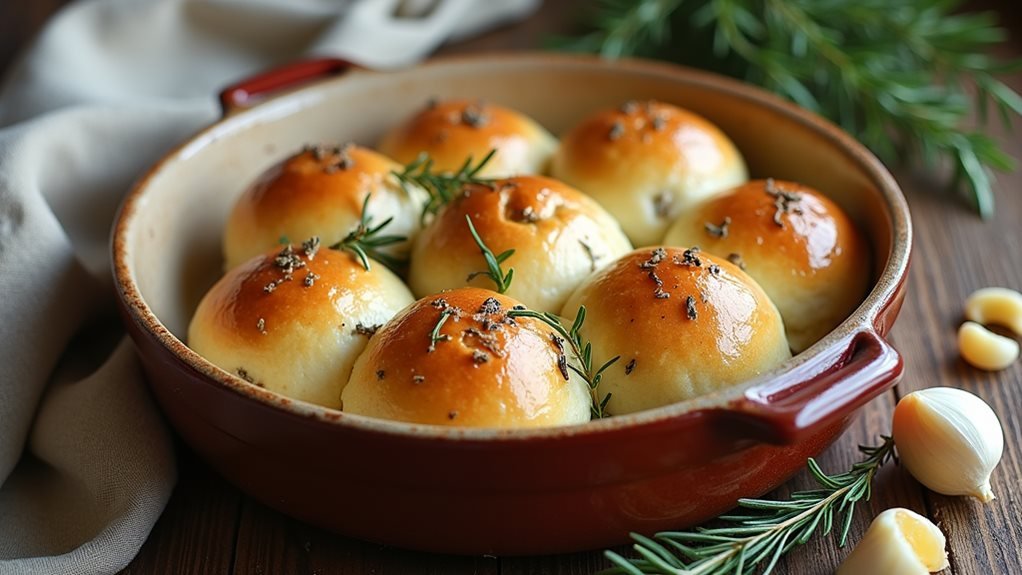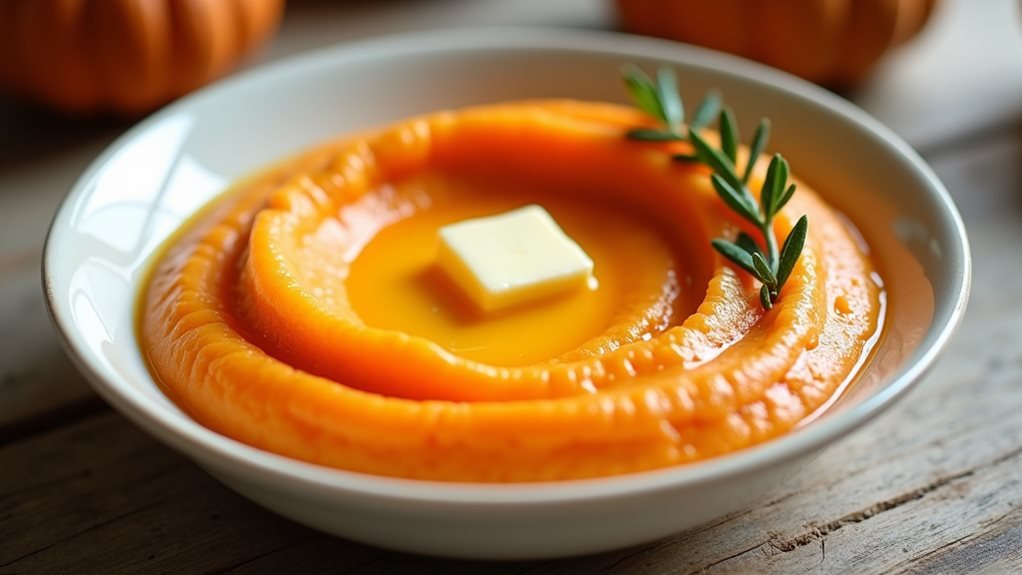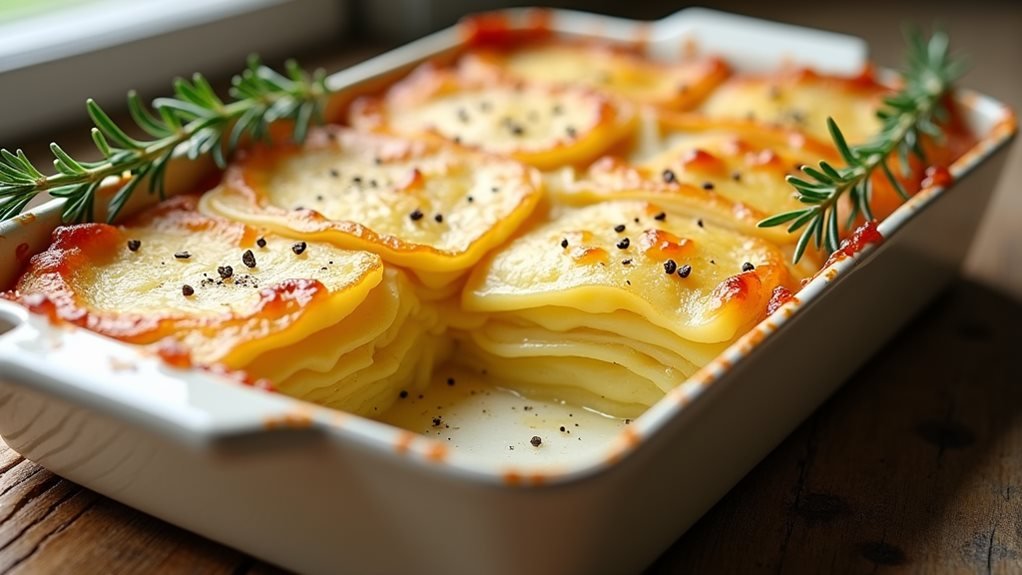You’ll realize that Gordon Ramsay’s interpretation of rosemary dinner rolls goes beyond the usual dinner table staple. These fragrant, garlic-infused rolls take cues from classic European baking while integrating the chef’s distinctive focus on technique and flavor harmony. Whether you’re presenting them with a festive banquet or enhancing a relaxed weeknight dinner, these rolls provide more than just a vessel for butter – they’re a culinary journey in their own right. The key lies not only in the components but also in Ramsay’s systematic method to achieve the ideal texture and crust.
Recipe Insights
- Combine fresh rosemary and minced garlic with high-quality bread flour for an aromatic, Ramsay-style base dough.
- Brush rolls with olive oil and garlic-infused butter before and after baking for maximum flavor penetration.
- Create uniform, golf ball-sized portions and arrange them close together for a soft, pull-apart texture.
- Proof dough twice: once after kneading and again after shaping, ensuring proper rise and texture.
- Finish with flaky sea salt and fresh rosemary sprigs on top before baking until golden brown.
History
The origins of rosemary dinner rolls can be traced back to ancient Mediterranean cultures, where rosemary was valued not only for its aromatic flavor but also for its preservative properties in bread-making. Roman bakers were among the pioneers who incorporated this fragrant herb into their daily bread, believing it would extend shelf life while adding a distinct taste that complemented their meals.
During medieval times, you’d have observed rosemary rolls gain popularity throughout Europe, particularly in monasteries where monks perfected the art of bread-making. They uncovered that the herb’s natural oils helped prevent mold growth, while its pine-like essence enriched the bread’s flavor profile.
By the 16th century, rosemary bread had become a staple at formal dinners across England and France, where it was often served to distinguish upper-class dining experiences.
Today’s rendition of rosemary dinner rolls represents centuries of refinement, combining traditional techniques with modern baking methods. While the basic concept hasn’t changed much, contemporary bakers have fine-tuned the balance of ingredients to create rolls that honor this rich culinary heritage. Much like Thomas Keller’s techniques for coaxing out flavors, modern chefs have discovered that rosemary’s aromatic properties can be enhanced through precise timing and temperature control.
Recipe
Rosemary dinner rolls combine the earthy fragrance of fresh herbs with the comfort of warm, homemade bread. These golden-brown rolls feature a perfect balance of garlic and rosemary, making them an excellent accompaniment to holiday meals or casual family dinners.
The secret to these rolls lies in their dual-rise process, which creates a light, airy texture while maintaining a satisfyingly crispy exterior. When served warm from the oven, they release an irresistible aroma that draws everyone to the table, ready to tear into their soft centers.
- 4 cups all-purpose flour
- 2¼ teaspoons active dry yeast
- 2 tablespoons fresh rosemary, finely chopped
- 4 cloves garlic, minced
- 1½ cups warm water
- 1 teaspoon salt
- 2 tablespoons olive oil
- 1 egg (for egg wash)
- 2 tablespoons butter, melted (for brushing)
In a large bowl, combine warm water and yeast, letting it stand for 5 minutes until foamy. Mix in flour, chopped rosemary, minced garlic, salt, and olive oil, kneading for 8-10 minutes until smooth and elastic. Place dough in an oiled bowl, cover with plastic wrap, and let rise for 1 hour in a warm spot.
Punch down the dough and divide it into 12 equal portions, shaping each into a ball. Place the rolls in a greased 9×13-inch baking pan, cover, and let rise another 30 minutes. Brush with egg wash and bake at 375°F for 20-25 minutes until golden brown. Brush with melted butter immediately after removing from the oven.
For best outcomes, maintain the water temperature between 105-110°F to activate the yeast properly. Store fresh rosemary in a damp paper towel in the refrigerator to keep it fresh longer. The dough can be made ahead and refrigerated overnight during the initial rise – bring it to room temperature before shaping the rolls. To freeze, cool completely and wrap tightly in foil, then place in a freezer bag for up to one month. For an extra burst of flavor, consider adding smoked paprika, which pairs beautifully with garlic and rosemary.
Cooking Steps
You’ll want to start by precisely measuring your dry ingredients and combining them in a large bowl, making sure to distribute the rosemary evenly throughout the flour mixture.
Next, you’ll need to add your activated yeast mixture slowly while kneading, continuing until the dough becomes smooth and elastic but not overly sticky.
After letting the dough rise until doubled in size, you’ll shape it into rolls and brush the tops with egg wash before baking to achieve that perfect golden-brown finish.
Step 1. Measure Dry Ingredients Carefully
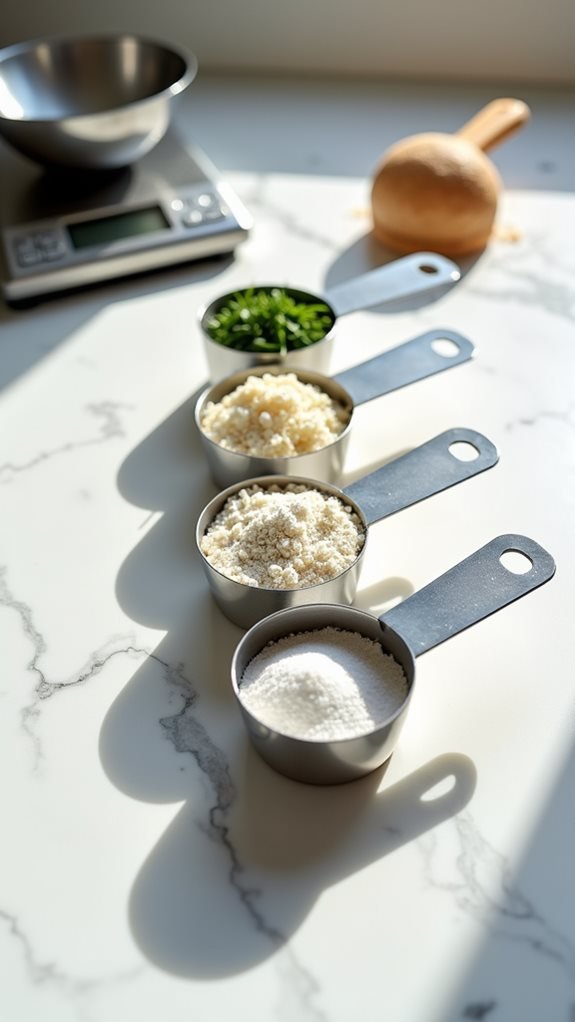
Accurate measuring of dry ingredients is crucial for consistently perfect dinner rolls. You’ll want to use appropriate measuring cups designed specifically for dry ingredients, not liquid measuring cups, as they’ll provide you with precise amounts needed for this recipe.
Start by spooning your flour into the measuring cup rather than scooping directly from the bag, which can compress the flour and lead to using too much.
When measuring the rosemary and minced garlic, make sure they’re finely chopped before measuring to maintain the recipe’s intended ratios. Level off each cup of flour with a straight edge, like the back of a knife, to remove any excess.
You’ll want to measure the yeast carefully using proper measuring spoons—even a slight variation can affect the roll’s rise and texture.
Remember to fluff your flour with a whisk before measuring to prevent compaction. If you’re doubling the recipe, measure each portion separately rather than trying to multiply the measurements in one go. This attention to detail will help you achieve the perfect texture and consistency every time.
Step 2. Add Yeast Mixture Slowly
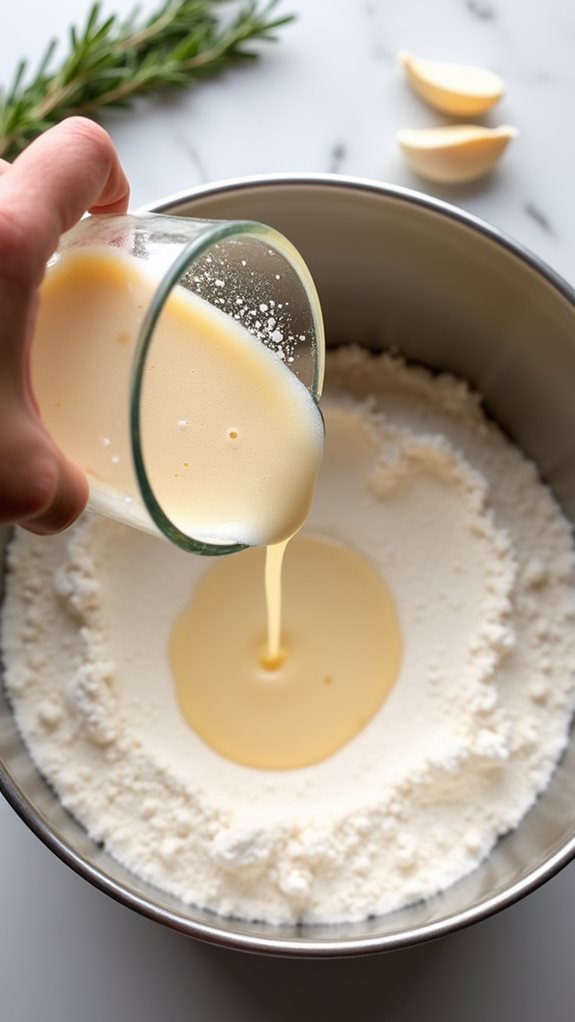
With your dry ingredients properly measured, it’s time to incorporate the yeast mixture into your dough. You’ll want to create a well in the center of your flour mixture, then gradually pour the bloomed yeast solution while stirring with a wooden spoon. This slow addition prevents flour from clumping and guarantees even distribution of moisture throughout the dough.
As you combine the ingredients, you’ll notice the mixture starting to come together. Don’t rush this process—add the liquid in three or four portions, incorporating each addition fully before adding more. Once the dough becomes too thick to mix with a spoon, switch from stirring to kneading. At this point, turn the shaggy dough onto a lightly floured surface.
Watch for the dough’s consistency as you work – it should feel slightly tacky but not sticky. If it’s too wet, add flour a tablespoon at a time; if it is too dry, sprinkle with small amounts of warm water.
The finished dough should pull away cleanly from the sides of the bowl and feel elastic when stretched.
Step 3. Knead Until Dough Forms
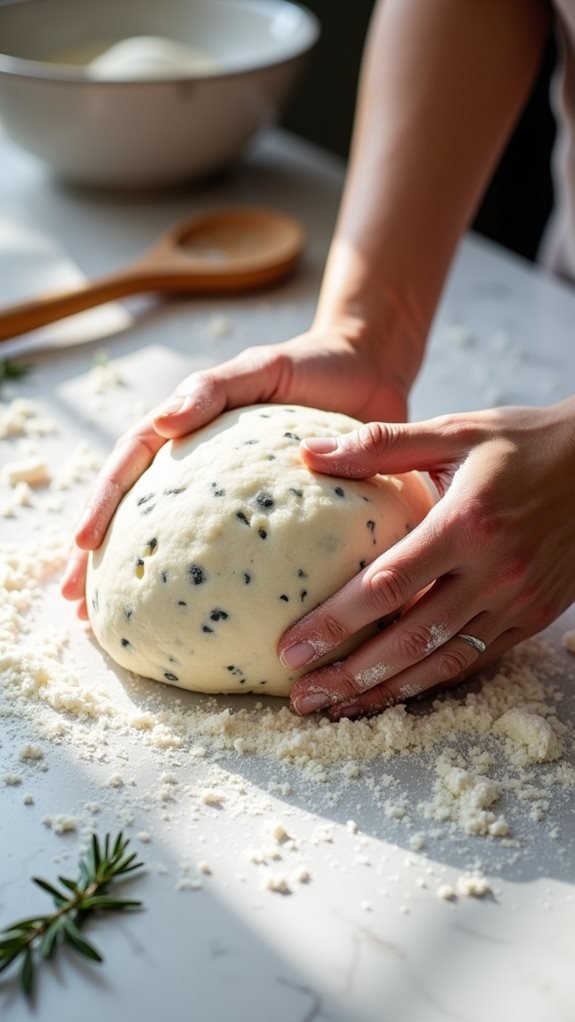
Kneading the dough marks a pivotal turning point in your dinner roll preparation. As you combine the flour mixture with the bloomed yeast solution, you’ll notice the ingredients gradually coming together to form a shaggy mass. This is when your hands become crucial tools in developing the dough’s structure.
Work the dough on a lightly floured surface, pushing it away from you with the heels of your hands, then folding it back over itself. You’ll need to continue this rhythmic motion for about 8-10 minutes until the dough transforms from sticky and rough to smooth and elastic. When you press your finger into the dough, it should slowly spring back, indicating proper gluten development. Don’t rush this process – proper kneading guarantees your rolls will have that perfect, pillowy texture that’s ideal for soaking up gravy or melted butter.
If you’re using a stand mixer with a dough hook, you’ll want to knead at medium speed for 6-7 minutes. Stop occasionally to check the dough’s consistency and scrape down the sides of the bowl as needed.
Step 4. Let Rise Until Doubled
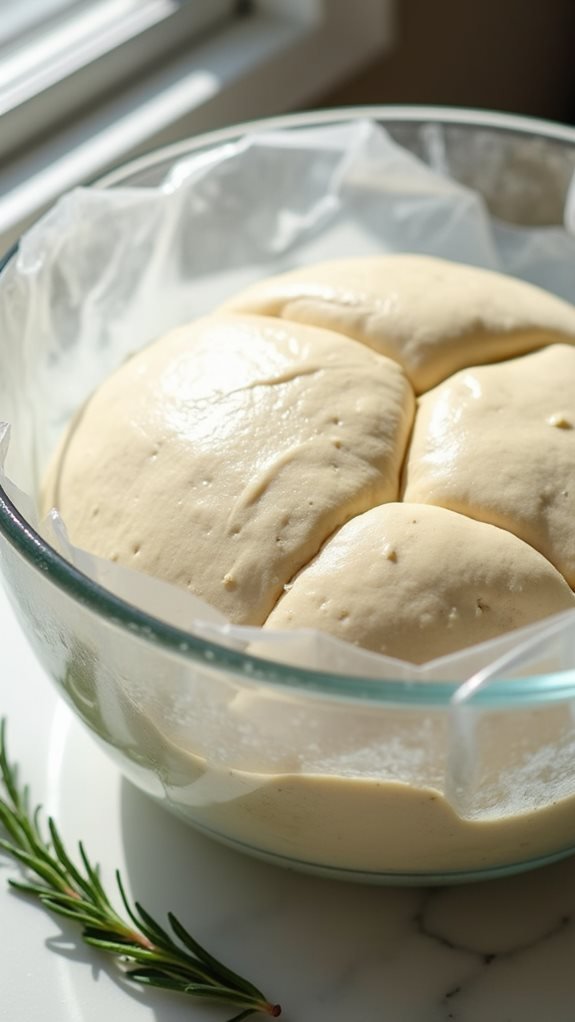
Once your dough has been properly kneaded, transfer it to a large, lightly oiled bowl and cover it with a clean, damp kitchen towel or plastic wrap.
Place the bowl in a warm, draft-free spot where the temperature stays between 75-85°F (24-29°C). Let the dough rise until it’s doubled in size, which typically takes about 60 minutes.
During this initial rise, the yeast will continue working its magic, producing carbon dioxide that creates tiny air pockets throughout your dough.
You’ll know your dough has risen properly when it’s puffy and springs back slowly when you gently press it with your finger. If it springs back immediately, it needs more time.
Don’t rush this essential step – proper fermentation develops both flavor and texture in your rolls.
If your kitchen’s particularly cool, you can create a warm environment by placing the bowl in your oven with just the light on.
Once the dough has doubled, you’ll be ready to punch it down and shape your rolls for their subsequent rise.
Step 5. Brush Tops With Egg Wash

The final step before baking involves brushing each roll with a simple egg wash made from one beaten egg mixed with a tablespoon of water. This pivotal step will give your rosemary dinner rolls that signature golden-brown sheen that’ll make them irresistible to your guests. You’ll want to thoroughly beat the egg mixture until it’s completely smooth, ensuring there aren’t any streaks of egg white visible.
Using a pastry brush, gently apply the egg wash to the tops of your rolls, taking care not to let excess mixture pool around the bases. Make sure you’re covering the entire surface evenly, including the visible sides.
If you notice any spots you’ve missed, don’t worry—you can go back over them, but try not to oversaturate the dough. The egg wash will not only add visual appeal but also create a slightly crispy exterior that contrasts beautifully with the soft interior.
For an extra touch of refinement, sprinkle a few fresh rosemary needles on top of the egg wash before baking the rolls.
Common Questions About This Recipe
Many homebakers have similar questions when making rosemary dinner rolls for the initial time. You’ll often wonder about the proper water temperature for activating yeast, which should be between 105-110°F – any hotter will kill the yeast, while cooler temperatures won’t activate it properly.
If you’re concerned about over-kneading, watch for the dough to become smooth and elastic. This typically takes 8-10 minutes by hand.
Another common question concerns storing these rolls. You can freeze them in an airtight container for up to one month, though you’ll need to thaw them completely before reheating.
If you’re wondering about substitutions, dried rosemary can replace fresh at a ratio of 1:3 (use 2 teaspoons dried for 2 tablespoons fresh).
For those asking about making ahead, you can prepare the dough the night before and let it rise slowly in the refrigerator. Just remember to bring it to room temperature before shaping the rolls.
If your rolls aren’t rising properly, check both your yeast’s expiration date and the ambient room temperature – warmer rooms promote better rising.
Final Thoughts and Serving Ideas
Freshly baked, these rosemary dinner rolls elevate any meal they accompany. Their aromatic blend of herbs and garlic creates an inviting atmosphere that’ll have your guests coming back for more.
These rolls aren’t just delicious on their own – they’re perfect vehicles for soaking up gravies, sauces, and juices from your main dishes.
For a sophisticated presentation, arrange the rolls in a rustic bread basket lined with a cozy cloth napkin to keep them warm. To enrich their savory profile, serve them alongside compound butter, such as honey-butter or herb-infused varieties.
If you’re hosting a larger gathering, consider doubling the recipe and placing bread baskets at both ends of the table for easy access.
Don’t forget to time your baking so the rolls emerge from the oven just as your guests are ready to eat. The warmth and aroma will create an unforgettable dining experience. If you’ve made them ahead, a quick 5-minute warm-up in the oven will revive their freshly baked qualities and crispy exterior.
